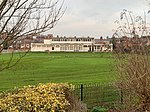Sabras Radio
Asian mass media in the United KingdomBritish Bangladeshi mass mediaBritish Indian mass mediaBritish Pakistani mass mediaLeicester ... and 3 more
Radio stations established in 1995Radio stations in LeicestershireUse British English from August 2014

Sabras Radio is an Asian commercial radio station based in Leicester, England, available on 1260AM and DAB. The radio station broadcasts to the East Midlands, Birmingham, Coventry, and Milton Keynes. It is also accessible online through SabrasRadio.com and through the mobile app SabraRadio, TuneIn and Simple Radio. Sabras Radio also hosts TV, Urban, Film, and many other great things. The presenters broadcast in Hindi and English covering topics of interest to the British Asian audience. The station features an "open-door policy", welcoming listeners from the street to join the presenters in the studio.
Excerpt from the Wikipedia article Sabras Radio (License: CC BY-SA 3.0, Authors, Images).Sabras Radio
Islington Street, Leicester Clarendon Park
Geographical coordinates (GPS) Address Nearby Places Show on map
Geographical coordinates (GPS)
| Latitude | Longitude |
|---|---|
| N 52.619 ° | E -1.1315 ° |
Address
Freemens Common Nature Reserve
Islington Street
LE2 7SQ Leicester, Clarendon Park
England, United Kingdom
Open on Google Maps





